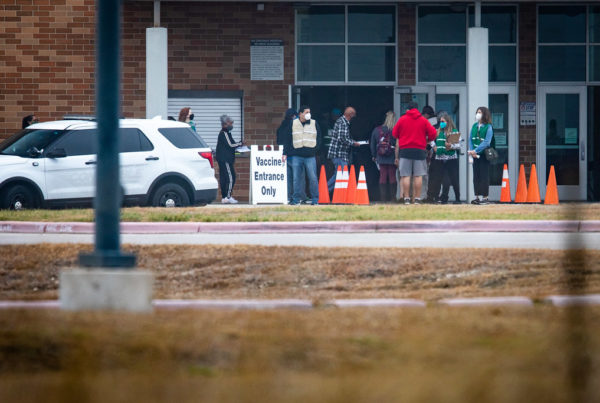From Texas Public Radio:
The Texas electricity grid failed because it wasn’t ready for climate change. With more extreme weather on the horizon, experts say the grid needs to adapt.
Since the turn of the century, Texans have gone through record-breaking droughts, floods and, now, a deadly winter storm. The state’s lack of preparation — and the unwillingness to acknowledge the unfolding reality — have contributed to huge bills for consumers, an emerging financial crisis for the electricity market and dozens of deaths.
The energy grid in Texas is simultaneously unprepared for and actively contributing to the processes behind climate change. But because of the state’s historical reliance on fossil fuels, conversations about adaptation often lack candor — or don’t happen at all.
The science of climate change
If you watched a local TV weather report in early February, you probably heard the term “polar vortex.”
“So, the polar vortex is always there,” said Amanda Lynch. “There’s one over the North Pole, and there’s one over the South Pole.”
Lynch is the former chief editor for the Weather, Climate, and Society journal, the current vice chair of the United Nations World Climate Research Program, and the Lindeman Distinguished Professor of Environmental Studies, Professor of Environment and Society and Earth, Environmental, and Planetary Sciences at Brown University.
She was also the first person to create a regional climate model of the Arctic. To understand the winter storm that hit Texas — and how humans likely contributed to the process behind it — you have to understand what’s going on with the “polar vortex.”
“It’s caused by the fact that the polar regions get much less sunlight than the tropical regions,” Lynch said. “And so you can think of the entire earth as a heat engine that’s receiving heat from the sun in the tropics and moving it up towards the poles where it’s leaving the earth — and that is in balance. And if that’s in balance, the temperature of the planet doesn’t change.”
Humans have polluted the Earth’s atmosphere with an enormous amount of heat-trapping gases, like methane and carbon dioxide.
“And so what we’ve done is we’ve disrupted the balance of that heat engine — of energy coming in in the tropics, and leaving in the poles,” she said.
And that disruption has caused something called “the jet stream” to behave more erratically. In case you aren’t familiar, you can picture the jet stream as this big piece of string loosely wrapped around the globe, with lots of bends and curves – “waves” of weather.
“Those waves are the waves that we see that cause the passage of weather systems,” Lynch said. “And the bigger the waves, the more cold air comes south in the lower part of the wave, and the more warm air goes north in the upper part of the wave.”
At a global level, the planet is heating up. But the symptoms of climate change include severe weather of all kinds, from deadly cold snaps to extreme hurricanes. The exact mechanisms that lead to these powerful weather events are still being researched, but, according to Lynch and many other researchers, the bigger waves of the jet stream are certainly attributable to the changing climate.
Texas energy officials grapple with climate change conversations.
During a press conference on February 19, after most Texans had power restored, officials with the Electric Reliability Council of Texas (ERCOT) responded to a question from Texas Public Radio about climate change.
ERCOT is the operator of the Texas electric grid. It doesn’t own the pieces of the grid or make rules, but it does create “seasonal assessments” of electricity demand. Many industry players look to those predictions to plan ahead. And in this case, ERCOT’s initial demand forecast was far short of the record-breaking electricity demand the state actually saw.
The question: “Climate change is making extreme weather events like the storm we saw this week more probable. Does ERCOT recognize this reality, and will it prepare for a storm even worse than the one we just saw?”
ERCOT CEO Bill Magness answered first.
“Well, we do an assessment of what we expect in the coming season,” he said. “And in that assessment, we take a look at all the weather and all the weather data going back. And I think as we look at, you know, having seen a storm that was so much enormously more demand than had been seen before — that certainly sets a new standard.”
He didn’t actually say “climate change,” or directly answer the question. But, as one of his former bosses told TPR, “Everyone knows about this.”
That former boss is Peter Cramton. He was vice chair of the ERCOT board until he resigned in late February amid political turmoil. And during his half decade with the board, he was part of many climate-adjacent conversations.
“Texas is the energy capital of the United States, and historically, that has meant fossil fuels. And the fossil fuels industry are not too excited about climate change,” he said. “And so those politics certainly limit the way one talks about these issues.”
But, Cramton said, despite the delicate nature of climate change-related conversations in Texas, officials at ERCOT are still making decisions with this information in mind.
“The conversation changes a little bit,” he said. “But everyone understands that the world is changing, and we have to respond with an energy market for the future — not one of the past.”
That’s a bit different from the message we heard from the governor of Texas during the crisis, when he appeared on Sean Hannity’s Fox News program to point the finger at wind and solar power. But ERCOT officials have said — and their data backs this up — natural gas issues were responsible for the biggest problems.
‘An energy market for the future’
There’s actually another power source — one that Gov. Greg Abbott didn’t mention on Hannity’s show, and one that’s gone mostly unnoticed. And it may have been a surprise savior.
“What we saw in this particular situation is that the Texas hydro system was flowing much higher at times when we know the grid was in trouble than it has historically,” said Emily Grubert, an assistant professor of Civil and Environmental Engineering at the Georgia Institute of Technology.
“And when you look at the specific release profiles from a couple of the dams in the Austin area: right when the grid started to get into trouble, you see all of these spikes. So, it’s pretty clear that they were trying. I think they probably did help quite a bit,” she said.
Aside from being used as an emergency power source — potentially staving off a complete collapse of the grid that could have led to an indefinite blackout — hydroelectricity is also useful as a case study in energy tradeoffs. Every energy source has ups and downs.
Dams, for example, don’t emit greenhouse gases.
“On the other hand, we probably won’t build more, largely because they create these really, really significant ecological impacts that are often not mitigatable,” Grubert said.
Those ecological impacts include turning a river into a lake, which often disrupts sedimentation patterns and adversely affects fish. The dam-building process can also cause displacement of people.
Hydroelectric power sources make up a very small fraction of the Texas power supply. But other problematic power sources are used in huge amounts.
Fossil fuels, for example, emit greenhouse gases. Those gases contribute to the same climate change that causes extreme weather. And that extreme weather, as Texas saw, leads to more fuels being burned.
According to Grubert, the necessary route — what Peter Cramton calls “an energy market for the future” — is clear, and it includes more than just where Texas gets its energy from.
“Going the renewable route is the route to go on the supply side. I think this is also a really important conversation about the demand side, though, too,” she said. “Because all industrial energy systems do have impacts, trying to reduce the overall amount of energy that we need to provide services at the level that we want to is a huge piece of this too. So, having your buildings be more energy efficient and stuff like that — that reduces the number of new power plants that you have to build over time as we start to see this decarbonization process.”
There are many proposals in the Texas state legislature on how to address last month’s failure of power. For now, the focus will be on weatherizing existing power plants — which means a large-scale investment in the same fossil fuels technologies that are changing the climate, leading to more extreme weather, more often.















